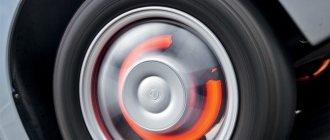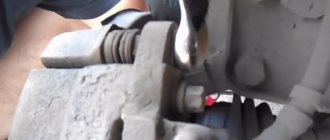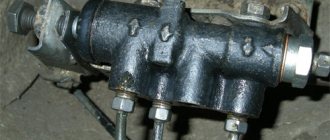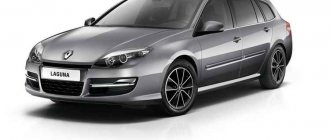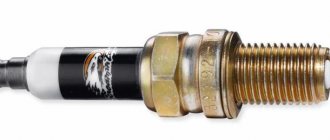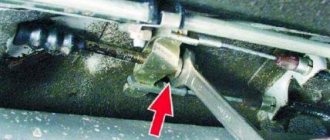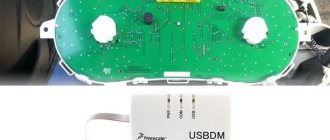When do you need to change brake pads?
The brake system is an essential component, the correct functioning of which determines not only the performance properties of the vehicle, but also road safety in general. The procedure for diagnosing and servicing the brake system includes a number of mandatory operations, among which timely replacement of brake pads is mandatory. But how do you know when to change your brake pads?
How to accurately determine the need for replacement
1. Visual inspection of the brake mechanisms. We carry out a visual inspection during scheduled (seasonal) tire replacement, as well as in cases where there are characteristic signs indicating a malfunction of the brake system. The condition of the brake pads is best controlled on disc brakes; on drum-type brake mechanisms, the thickness of the friction linings is checked through a special hole in the protective casing, or after removing the drum.
2. Measure the thickness of the pads. As a rule, the car manufacturer specifies the minimum permissible thickness of the friction linings, upon reaching which the brake pads need to be replaced. It is worth remembering that the value of this indicator depends on the make and model of the car, the design of the brake mechanism, as well as the type of friction material used in the pads.
It should be noted that the frequency of replacing brake pads is not regulated by either the duration of their operation or the mileage of the vehicle . Either you or a service station technician can determine when you need to change the brake pads. It is important to remember that due to the special importance of the braking system for traffic safety, it is recommended that its service be carried out exclusively in specialized service centers.
To reduce speed, modern cars use mechanisms that use friction force in their design and materials with high friction properties. At the same time, even high-quality brake pads are subject to wear during operation and after a certain time they need to be replaced. We'll figure out when to change the brake pads and determine the interval by time or mileage.
When to change pads
1. In accordance with the recommendations of the car or pad manufacturer.
A very controversial point, since the mileage a car travels, operating conditions, driving style are different for everyone. For some, the pads will last for a couple of years, for others – for a season. The manufacturer's recommendations are nothing more than recommendations, you need to listen, but whether to follow them or not depends on the factors listed above. 2. When the thickness of the friction linings becomes less than 5mm. This is an unconditional point and should be followed in any case. There are craftsmen who feel sorry for changing: “they’re still thick, you can ride.” In principle, yes, but you can get into trouble. When driving for a long time on worn pads, the piston of the brake cylinder constantly “peeks out” from the boot - the pad is thin and the piston stroke is increased. As a result, minor rust may form on the piston surface. And after replacing the pads, the cylinder is recessed, and this rust gets directly onto the sealing seal of the brake piston. As a result, the cylinder leaks, it needs to be replaced, and hassle with bleeding the brakes. I hope I convinced you - thinner than 5 mm. - change the pads.
3. Increased pedal travel, squeaking brakes, warning light. I’ll tell you about squeaks and pedal travel a little later, but here I’ll just add that the ideal option is if the car is equipped with a pad tracking system. If there is excessive wear, a light will come on on the instrument panel (unfortunately, such a system is not available on all cars). What if your car is not equipped with a state-of-the-art brake pad monitoring system (consisting of two contacts and a light)?
Signs of Brake Pad Wear
There are several signs by which you can determine the time, if not for replacing the pads, then at least for a preventive inspection.
1. Increased travel of the handbrake lever. Relevant for rear pads. Previously, the handbrake clicked 3-4 times, but now it has become 5-7, or the car, with the handbrake pulled, rolls down the slightest hill - check the pads. Maybe the reason is a stretched cable, but don’t tempt fate - check the pads, and of course, check the front ones too.
2. Increased brake pedal travel and decreased braking efficiency. There could be a simple brake fluid leak, but if everything is dry, it’s worth checking the pads.
3. Various creaks, noises, knocking when braking, and sometimes vibration. Vibration relates to the disc brake system (as on the front wheels), and can indicate, in addition to pad wear, disc warping - it’s a good idea to check: spin the disc and watch the beats. If the “figure eight” is visible - like on an old bicycle wheel, the disk must be replaced or re-grooved (if thickness allows) - there are no options.
No conversation about pads would be complete without mentioning a few things you need to know.
1. After replacing the pads, perhaps for several tens of kilometers the brakes will be worse - in any case, there is wear on the brake disc or drum, and while the pads are rubbing in, there is no need to be reckless.
2. Change all the pads on the axle, or even better, on the entire car. Don’t even think about replacing the pads on the left and leaving the old ones on the right. Such savings are a direct path to problems with brakes.
3. Inspect the pads according to the season - when you “change shoes” of the car - change winter tires to summer tires, and vice versa.
4. When replacing pads, inspect the condition of the discs and drums. If there is significant wear or deep longitudinal grooves appear, it is better to replace it.
And lastly, although this point is more likely to be classified as a curiosity, it nevertheless happens regularly. When replacing the pads, do not forget to take some fluid from the brake reservoir. If it is full, then at the time of replacing the pads (when you press down the pistons of the brake cylinders), the liquid will go back into the reservoir, and then through the top of the reservoir, leading to a local cataclysm. Any paint really does not like liquid - if you do not wash it off in time (which is very difficult - it will flow everywhere), it can destroy and lift the paint. I hope that after reading the article, you now have answers to your questions: when do you need to change brake pads, and what are the symptoms of their wear.
Operational Factors
Some drivers carry out the replacement after 50...60 thousand km, while for others the deadline comes already at 10...15 thousand km . The main factors in this situation are the method of operation, driving style, pad manufacturer and type of brake system.
It is also worth paying attention to the accompanying elements of the system, the condition of which determines how long it takes to change the brake pads:
- adjusting rods with fasteners;
- various seals and protective boots;
- cuffs and hydraulic hoses;
- damping springs or fixing brackets.
The wear of these components also leads to rapid wear of the friction linings.
The quality and design of brake discs or drums has a direct impact on the overall performance of the brakes. Ventilated discs from well-known manufacturers will last much longer due to optimal conditions, and the mileage of the pads with them will increase.
When diagnosing the brake system, it is worth checking that the caliper is installed correctly. Its misalignment affects the uniform wear of the pads. This property also affects braking efficiency. This phenomenon can be noticed by the unevenly wiped lining.
Design features
Most experts recommend inspecting and sometimes even replacing the pads on disc brakes of domestic cars after a mileage of 10...15 thousand km. Rarely do budget cars exceed this interval of 20 thousand km. For foreign designs, the permissible period will be 15...20 thousand kilometers. Corrections are made depending on driving style.
For the drum brake design, the motorist may not have to worry sometimes even up to 100...150 thousand km. Therefore, the answer to the question of how often to change brake pads depends, in addition to operational factors, also on the design of the system.
It is important to have an idea of the material from which friction linings are made. Automakers sometimes include dozens of components in order to ultimately achieve the required properties from the material. The result is smooth and quiet operation, but they remain grippy even under aggressive driving style.
The structure of the linings comes in several types:
- Polymetallic . The material has durable properties and has high heat transfer. It contains 25...60% of metal compounds from steel powder, copper inclusions or metal webs. Disadvantages include increased noise during operation, as well as a possible decrease in efficiency during frosts.
- Non-asbestos . After the ban on the use of asbestos, manufacturers began to use organic materials, including glass, rubber and Kevlar components. Braking with them is quite soft and quiet. However, with intensive use, the pad wears out quickly, turning the pads into dust.
- Low-metallic e. The composition of the material is a compromise between the previous types, and they can be found most often on the shelves. Domestic automakers use this type of pad in the basic configuration of modern cars. Up to a third of copper material is used in the structure or steel mesh is used. An increase in the mass fraction of metal inclusions can cause more noise when braking.
- Ceramic . The material belongs to the most advanced technologies with improved quality. Although their price tag is higher than similar ones, this is compensated by increased lightness, less noise and a reduced degree of wear. The basis is ceramic fibers and a small amount of non-ferrous metals. Due to the solid base, they do not create dust. The products quickly pay for themselves due to their long service life.
By replacing the pads from the basic equipment on your car with better ones, for example, ceramic ones, you can forget about the problem with the brakes for several tens of thousands of kilometers.
Recommendations for selection
The modern market provides potential customers with a wide selection and range of brake pads. Of course, the best ones are the original ones from the manufacturer. However, they are not always available, and the price is much higher. Therefore, drivers more often choose non-original products from manufacturers that have proven themselves to be of high quality and reliable.
Akebono is a leading Japanese manufacturer of components and assemblies for brake systems for cars and motorcycles. The company was founded in 1929 and from the very first day of its existence it has been developing, constantly improving, units and parts for car brake systems.
Akebono is, first of all, a guarantee of the safety and quality of the material. Every fourth car produced in Japan is equipped with brake systems from this company. A special feature of the company is that it supplies the secondary market with the same pads that are installed on new cars.
It was Akebono that first used ceramics in the production of brake linings, which created a sensation in the world of automobile braking systems. Such pads made virtually no noise and damped vibrations, while maintaining a constant coefficient of friction even over wide temperature ranges.
Real Akebono brake pads do not contain ferroalloys, so there is no friction between the metal elements of the pad and the disc.
Akebono brake pads are suitable for Ford, Mazda, Skoda, Toyota, Honda, Mitsubishi, Subaru, Isuzu, Nissan, Suzuki models.
The advantages of Akebono brake pads are:
- Wide operating temperature range. Thus, the pads are able to effectively brake when the disc is heated from 0 to 650°C. And this does not include special sports versions.
- The ceramic composition of the pads, in comparison with organic material, practically does not emit dust.
- No squeaks or rattles. All the same ceramic composite materials are silent and do not allow metal contact.
- Reduced abrasiveness of ceramic material. This allows you to increase the service life of the disk.
- High pad performance and durability. Even with an aggressive driving style, they can last up to 50 - 60 thousand km.
- The optimum ratio of price and quality.
Characteristic disadvantages of Akebono brake pads are:
- With increased wear of the brake disc, “smooth” braking is observed, even with the pedal pressed hard.
- Possible squeaking at low speeds.
Thus, genuine brake pads from Akebono are an excellent and high-quality material that has proven itself all over the world. By installing such pads on your car, you can be sure that the same ones are installed on many HONDA, MITSUBISHI, TOYOTA models.
The German company ATE was founded at the beginning of the 20th century. And since the mid-30s, the company has taken a leading position in the production of brake systems.
So, today, brake systems from ATE are installed on Mercedes, BMW, Skoda cars. The company's products are characterized by maximum reliability, and the use of innovative technologies, namely alloys of cast iron with nickel, chromium, molybdenum and titanium, guarantees minimal braking distance and reliable operation of the entire braking system even at temperatures above 700°C.
ATE brake pads are completely asbestos-free, maintaining a constant coefficient of friction and the ability to press against the disc during emergency braking with a force equal to 2-3 tons.
ATE brake pads are suitable for Audi, Ford, Mercedes, Renault, Voivo, BMW, Honda, Mitsubishi, Skoda, Chevrolet, Hyundai, Mazda, Toyota and domestic VAZ models.
The main advantages of ATE brake pads are:
- Smooth braking while maintaining rigidity and inevitability of the system.
- No extraneous noise or rattle.
- High level of contact between the pads and the brake disc.
- Resistant to overheating, while working well in low ambient temperatures.
Among the shortcomings, users most often indicate:
- High dustiness, in which the car's rims become covered with a dark layer of worn out linings.
- The softness of the linings, expressed in their quick erasing.
- High price.
ATE brake pads are a product that can meet the needs of almost any driver. Despite their high price, they are high quality, environmentally friendly and capable of operating under the highest load.
Lucas/TRW brake pads are the most common on the Russian market. And this is not surprising. Lucas/TRW is the world's premier brake system manufacturer, creating and supplying equipment to leading automotive and aerospace manufacturers.
The use of advanced technologies and high capitalization in inventive and scientific activities allow the company to constantly improve the systems it produces and be competitive.
Lucas/TRW brake pads are supplied directly to the assembly lines of most European cars. And this takes into account the inflated European requirements for safety and environmental friendliness.
Lucas/TRW brake pads are suitable for almost all European car manufacturers, as well as Russian VAZ and GAZ.
The main positive characteristics of brake pads from TRW are:
- Budget and relatively low price.
- The use of innovative materials in the manufacture of linings, which made it possible to achieve high wear resistance and trouble-free operation life.
- Smooth braking.
- No dust.
However, Lucas/TRW brake pads are not ideal and there are a number of disadvantages in their use:
- The presence of extraneous squeaks and grinding sounds when you press the pedal, and this can occur immediately after installing new pads.
- The effectiveness of the braking system is reduced in adverse weather conditions.
- Uneven braking at high speeds.
- Low efficiency at low temperatures of the disc and pads themselves.
In general, Lucas/TRW brake pads are a good and worthy choice that allows you to be confident in the quality operation of the entire braking system. However, due to their widespread use, Lucas/TRW brake pads are most often counterfeited. And counterfeit products do not correspond to the quality characteristics of the original, and hence the possible negative impact towards Lucas/TRW.
Ferodo is an English company that manufactures friction linings. Ferodo brake pads are a high quality product at a reasonable price.
The company's specialists have developed a unique composition that includes high-strength ceramics, special resins, rubber and special fibers that provide a reinforcing effect.
Brake pad linings are made from this alloy. In addition, the manufacturer excluded copper and asbestos from the main composition. This made it possible to increase environmental friendliness while maintaining the performance properties of the pads.
Ferodo offers potential customers a varied range of brake pads, from exclusive models suitable for sports cars to reduced price models suitable for use in urban vehicles.
Ferodo brake pads are suitable for Audi, Ford, Mercedes, Renault, Voivo, BMW, Honda, Mitsubishi, Skoda, Chevrolet, Hyundai, Mazda, Toyota and domestic VAZ models.
The main positive properties that distinguish Ferodo pads are:
- Minimum brake pad break-in time.
- High wear resistance and working ability at any speed and temperature.
- Predictable braking and reliable maneuvering.
- Relatively low price.
- A variety of design options and price gradations.
- Good disc-saving properties.
Negative properties according to users:
- Presence of squeaks.
- Increased dustiness.
- Reduced efficiency in adverse weather conditions.
- Dispersion of friction coefficient values during braking at different speeds.
Nisshinbo is the largest Japanese manufacturer of original spare parts, supplying its products directly to the assembly lines of Japanese auto giants.
A distinctive feature of Nisshinbo brake pads is the use of linings at the base, which ensures high braking efficiency in all operating conditions and increased wear resistance.
Nisshinbo offers a wide range of brake pads that differ from each other in individual features and the use of different composite materials.
Thus, the Japanese company produces pads for passenger cars, for cars used as taxis, for SUVs and minibuses, for heavy trucks.
Nisshinbo brake pads are produced for Acura, Honda, Nissan, Suzuki, Mitsubishi, Subaru, Toyota cars.
The distinctive advantages of Nisshinbo brake pads are:
- Exceptional parameters for the effect on the brake disc.
- Braking stability.
- Low noise.
- Increased wear resistance.
- Maximum recovery from overheating.
Users note the following disadvantages of Nisshinbo brake pads:
- Increased dustiness of the pads.
- The ferodo may peel off.
In general, Nisshinbo brake pads have proven themselves all over the world and are popular for good reason. The only factor that needs to be taken into account is the selection of pads based on quality and driving style.
Under the PAGID brand, the TMD Friction group of companies produces and sells brake pads.
Since the mid-20th century, Ford and Volkswagen have been equipped with PAGID brake pads. The range of brake systems and spare parts of the German company is wide and varied: from pads for family and passenger cars to sports and heavy-duty vehicles.
Block as the main unit of the machine
A shaped metal plate with an integrated lining made of friction-resistant materials is a car block. It is the pad that makes direct contact with the disc; its composition determines how quickly the car’s brakes work. The main ingredients in the production of such a part are:
The listed materials allow the brake pad to effectively perform its functions while under constant exposure to an aggressive environment. Regular temperature fluctuations, which are caused by moisture entering the brake disc, ultimately lead to the appearance of cracks and subsequent failure of the pad. In addition, the intensity of braking and the driver’s driving style in general play a significant role in this process.
Replacing brake pads on disc brakes
Installing and replacing rear brake pads is significantly different from replacing drum brakes. Here you need not only standard screwdrivers and wrenches, but also special pullers that are designed for the car system.
- First you need to loosen the hand (parking) brake cable;
- the handbrake lever is released;
- the adjustable pins must be knocked out and the locking spring removed;
- brake pads and pads are removed;
- the caliper surfaces need to be cleaned because the caliper surface is in contact with the brake pads;
- You must simultaneously check the condition of the dirt cover for mechanical damage. If there is such damage, then you will need to completely rebuild the caliper;
- Next, check the friction surfaces of the brake discs for mechanical damage and measure the thickness of the brake discs. The manual pre-specifies the minimum permissible thickness of the brake discs, so that after a few days you do not have to change the brake discs;
- Next you need to push the pistons of the brake cylinder into the cylinder;
- then install the brake pads. Both sides of the gasket should be lubricated with a thin layer of silicone grease. The gasket is installed on the rear plate of the block. Next, install the brake pads;
It is important that if during disassembly the brake pad was removed from the caliper, then brake fluid will need to be added to the reservoir, and the brakes will also need to be pumped. Make sure brake fluid is not leaking
Then you will need to adjust the brakes.
Factory service life
How long does it take to change brake pads on a car? What frequency of replacement do the creators of this part directly require? Let's look at how often the pads need to be changed, in their opinion:
- The domestic manufacturer recommends replacing the front brake pads with new ones every 10-15 thousand km.
- The quality of the material at foreign factories is somewhat higher, so on foreign cars the distance traveled increases to 15-20 thousand km.
- Sports cars even mercilessly destroy linings of any composition; on such models, the lining wears out after 5 thousand km.
Wear level diagnostics
If the car is not your age, then it is most likely equipped with a special device that signals when the pads are worn out. The wear sensor is activated and emits a characteristic squeak when the metal base touches the disc. Please note that it is not a grinding sound, but the sound of the device.
How can owners of Zhiguli cars determine the wear of an element, since such limiters were not installed on older VAZs. In this case, dear friends, you will have to remove the wheel and measure the thickness of the lining; it should be at least 1-1.5 mm. Another clear sign of worn pads is increased brake fluid consumption. The fact is that in the absence of support for the caliper in the form of a friction lining, its pistons extend as much as possible in the direction of the disc, which leads to loss of fluid. If you have been trained at a driving school, you probably remember the words of the instructor that the car signals in advance about any future problem, in order to avoid it you need to be a little attentive and ready for action, that is, repairs. Worn pads are no exception; they tell us this in a variety of ways:
- Skidding when braking;
- When you press the brake pedal, you feel it vibrating;
- Soft pedal with increased travel;
- Low braking efficiency;
- No parking brake even with the cable pulled.
If after all this you do not understand how to determine the need to replace the pads and you can already hear a grinding noise in the wheel whenever the car moves, immediately go to a car shop. In this case, comrades, all that is left of the braking element is a metal plate, which will ruin the working surface in a short period of time. After this, replacing the brake discs is just around the corner, if their thickness is less than 11mm, then your time has come. Therefore, it is better to pay attention to the car signals and get away with a slight fright.
Urgency
Now it’s time to answer the main question: how long do brake pads last on a car and when should they be changed? What affects their wear and the maximum mileage that is possible for a car without maintenance?
One of the fundamental factors that affects how long a car runs on the same brake pads is driving style. It's no secret that exactly how the braking is done and how often the driver has to press the pedal directly affects the service life of the brake pads and how long they last from replacement to replacement.
Obviously, the less often you have to brake, the longer the service life of the brake pads and the longer they last. However, we should not forget that the force that the pads exert on the disc has a very significant effect on the service life of a particular consumable. In this regard, to save money, it is recommended to brake as smoothly as possible and only at those moments when it is really necessary. It is worth noting that the difference in how long the pads travel with a calm and aggressive driving style is significant, and in some cases it reaches an impressive 35–40%.
Conclusion
Despite all the recommendations of manufacturers or familiar car enthusiasts, deck wear is an individual matter. After all, this factor is influenced by certain qualities that differ for each driver. The level of wear of brake discs, their technical condition, the driver's driving style and much more lead to the fact that the frequency of replacement is different for everyone and does not always coincide with the manufacturer's terms. Therefore, learn to understand your braking system, because in reality it is not that difficult. Plus, carry out periodic diagnostics for the appearance of various cracks or other mechanical damage to both the disc and the pad and you will be happy! With this in mind, be careful and don’t take things to extremes. See you!
>
When do you need to change brake discs?
Chevrolet Lacetti CDIX Logbook Replacing rear brake discs and pads
The condition of the brake discs will directly depend on the efficiency of the entire braking system and the adequacy of deceleration of the car. That is why, as soon as the first signs of wear on the brake discs appear, it is necessary to replace them, which will ensure the safe operation of the vehicle.
Symptoms of brake disc wear may include the following: an increase in braking distance, the car pulling to the side when decelerating, as well as a soft brake pedal that may sink slightly when starting to move. As soon as such signs appear, you should replace the discs yourself or at a service center, at the same time replacing the used brake pads.
Car manufacturers usually indicate the maximum and minimum thickness of the disks; accordingly, by trying on such a minimum thickness with a caliper, you can determine the degree of their wear. However, wear and damage can be uneven, with deep grooves appearing on the steel surface, resulting in significantly reduced braking performance.
It is also not uncommon for discs to warp, which occurs under the influence of high temperatures. If you first brake sharply several times and then drive your wheels into a puddle, then there is a high probability that cold water will fall on the hot surface of the disk, which will lead to the loss of its original shape. It is prohibited to operate cars with such damaged discs, since the efficiency of slowing down the car is significantly reduced, and at the same time the braking distance increases, which makes the operation of such a car simply unsafe.
Brake discs are replaced on each axle, so it will be impossible to save money and replace only one damaged disc. Technologically, replacing rear and front discs is no different, but to carry out such work you must have the appropriate tools and work experience. This will allow you not only to perform such a replacement of disks, but also to subsequently bleed the system, removing air from it and ensuring high-quality braking of the car.
On modern cars, discs may have built-in wear sensors, which are replaced simultaneously with failed spare parts. Note that on modern cars this work is somewhat more difficult, so in this case it will be impossible to replace the discs yourself. It is necessary to contact specialized service stations, whose specialists have relevant experience working with your car model.
27.02.2018
